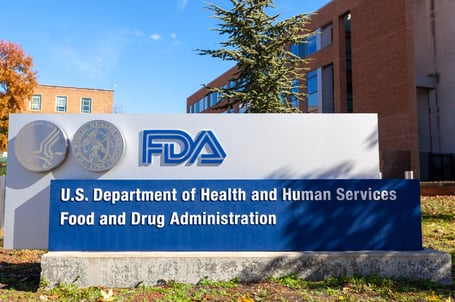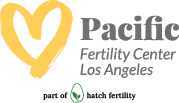US Requirements for the Use & Shipment of Eggs, Embryos, & Semen from Abroad
Navigating the Regulations Requirements
Patients and Intended Parents (“IPs”) considering a surrogacy journey using their own eggs, embryos, and/or semen must be aware of the regulations surrounding the use of human cells and tissues when using a Gestational Carrier (more commonly known as a Surrogate) in the United States.
Pacific Fertility Center Los Angeles (“PFCLA”), a top IVF clinic based in LA with over 30 years of experience with surrogacy journeys, is dedicated to guiding each patient and IP through their journey, enabling them to make well-informed decisions on their path to parenthood. With our in-house surrogacy agency, Hatch, we guide you through every step of the journey.

This blog post provides a comprehensive description of the requirements when using human cells and tissues donated abroad for surrogacy in the United States. Without the proper information, patients and IPs risk initiating a surrogacy journey with the wrongful assumption that they will be able to import and use their own human tissue or human cells created abroad.
This particularly applies to international patients and IPs who are either planning to donate eggs and semen abroad or create embryos, as well as those who already have frozen eggs, embryos, or semen that they wish to utilize with a Surrogate. It is far more likely that clinics and labs abroad do not meet the proper regulatory standards and carry the right certificates than clinics and labs within the United States.
The U.S. Food and Drug Administration (“the FDA”) regulates human cells or tissues that are used with the intention to be implanted, transplanted, infused, or transferred into a human recipient in the United States. The regulations apply regardless of using human cells and tissues that have already been donated and are kept frozen abroad and those that are yet to be donated for this exact purpose.
There are different sets of regulations for patients planning to carry themselves versus those looking to use a Surrogate. In this blog post, we will mainly focus on those cases which involve the use of a Surrogate.
Requirements for Human Cells and Tissues Used in Gestational Surrogacy
According to FDA regulations , any clinic and/or lab needs to assess donor eligibility before moving forward with retrieving and handling human cells or tissues. While exemptions to determine donor eligibility do exist, which will be discussed later, generally, the following is required to be in compliance with the FDA regulations:
- Screening for risk factors
- Testing for infectious diseases
- Registration with the FDA/Registration and listing of human cells and tissues
Screening for Risk Factors
The screening aims to minimize the risks of spreading communicable diseases through the donation and directed use of human cells and tissues. This involves a physical examination and a medical records review for the donor, both of which must be performed within six months before recovering human cells or tissues.
The physical examination should assess for physical signs of relevant communicable diseases and signs suggestive of any risk factor for such diseases. The medical records review is a documented dialogue concerning a donor’s medical history and relevant social behavior. Examples of relevant social behavior connected to the risk assessment could be the donor’s lifestyle related to the use of drugs and alcohol, sexual history for the last 6-12 months, etc.
Testing for Infectious Diseases
All specimens from reproductive tissue donors must be tested for several infectious diseases unless an exemption exists. The following tests are required:
- HIV type I and II
- Hepatitis B Virus
- Hepatitis C Virus
- Syphilis
- Chlamydia
- Gonorrhea
Sperm donors need to undertake additional testing to what is listed above, namely:
- Human T-lymphotropic virus (HTLV), types I and II
- Cytomegalovirus (CMV)
The tests listed above alone do not qualify the use of such human tissue and human cells. The screening test must be carried out using an FDA-licensed, approved, or cleared donor screening test. Additional acceptable tests might exist and are listed with the FDA. As far as international testing establishments, such as clinics and labs, are concerned, they are unlikely to have access to FDA-licensed, approved, or cleared screening tests. In addition, the screening test must be carried out in accordance with the manufacturer’s instructions, adding an additional layer of complexity for foreign establishments when attempting to carry out those tests properly. Most U.S.-based IVF clinics with experience working with international intended parents can ship “FDA Kits” to a foreign clinic for use in fulfilling this requirement. Still, patients and IPs need to understand that this does not exempt them from the other requirements listed in this blog post.
The time of testing in relation to the donation itself is also of great importance to complying with the regulations. A directed semen donor must complete testing within seven days before or after the recovery of the semen, while the same applies to an egg donor, but with a different timeline: 30 days before or seven days after recovery of the eggs.
Registration with the FDA
Now that the proper screening and tests have been listed, patients and IPs need to understand that not every establishment that performs one or more manufacturing steps for the recovery, processing, storage, labeling, packaging, or distribution of human tissue and cells in accordance with the above will guarantee that the human cells or tissues can be used with a Surrogate in the United States.
The FDA also requires such establishments to be registered with the FDA and list their human cells and tissues within five days of commencing operations. The registration must be renewed annually.
 Any establishments outside of the United States that import, or offer to import, human cells and tissue into the country must follow these regulations. They also need to ensure that the testing required is done in a CLIA-certified lab (Clinical Laboratory Improvement Amendments) or equivalent. There are also very specific instructions on how the establishment should maintain their records and label human cells and tissues.
Any establishments outside of the United States that import, or offer to import, human cells and tissue into the country must follow these regulations. They also need to ensure that the testing required is done in a CLIA-certified lab (Clinical Laboratory Improvement Amendments) or equivalent. There are also very specific instructions on how the establishment should maintain their records and label human cells and tissues.
To search for registered establishments, you can visit the FDA Website.
We hope this blog post provides patients and IPs looking to donate human cells and tissue abroad for a surrogacy arrangement in the United States with an understanding of the regulations. Under the circumstance that all the requirements mentioned above are met, in accordance with timelines, proper tests, and registered establishments, human cells and tissue created abroad can be used for surrogacy in the United States.
This is not an exhaustive list, and there might be additional considerations as well as investigations necessary to determine eligibility. With that said, and as previously mentioned, there are exemptions that we will explore further below.
Exemptions to the FDA Regulations
While these extensive regulations exist to protect the recipient of the human cells or tissues, there are exemptions in specific situations, some of which are listed below:
- Cells and tissues created for autologous use (use by the donor themselves)
- Reproductive cells or tissue donated by a sexually intimate partner of the recipient for reproductive use
- Cryopreserved oocytes or semen initially planned for use according to the two situations above, which are later intended to be used for directed or anonymous donation (for example, a surrogacy arrangement)
- An exemption granted by the FDA on a case-by-case basis
An example would be when sexually intimate partners were not screened nor tested during the time of embryo creation and cryopreservation, but that later wish to use these embryos for directed or anonymous donation because they, for example, attempted one or several embryo transfers after which it is determined that the female partner cannot carry a fetus to term. There are still regulations that need to be considered, such as the length of the cryopreservation of the embryos before use (6 months) and surrounding screening and testing the semen and oocyte donors “when possible.” Still, generally, an exemption then exists to the required screening and testing as described in previous parts of this blog post.
The FDA can also grant exemptions directly, which includes a protracted process that requires a physician to petition the FDA in writing. A typical case would be a patient diagnosed with cancer requiring urgent treatment, where the embryos would be created immediately for fertility preservation. This scenario applies regardless of where in the world that would occur and also applies to sperm freezing.
Another possible scenario is when embryos were created for surrogacy without following the FDA guidelines, but the patient can no longer produce a new batch of embryos for medical reasons.
Patients and IPs finding themselves in similar situations, as described above, should always consult with an experienced IVF physician regarding their circumstances before pursuing a surrogacy journey in the United States. Experienced physicians at PFCLA are here to help.
International Shipment of Human Cells and Tissue
Patients and international IPs that can ensure that the regulations regarding testing and screening, as well as the establishments' registration and certificate, are met will want to explore the options of shipment. This also applies to exempt individuals or couples under the circumstances described above.
Shipments are usually handled by third-party shipment companies rather than the clinics that are in possession of the human cells or tissues or are receiving them. It is essential to consider both local as well as United States laws when moving forward with the shipment of such human cells and tissue. Some geographical areas/countries impose regulatory challenges for the exportation process.
Many experienced shipment companies provide the services of taking care of this precious cargo. Some offer a hand-carried option: having a person courier your cryopreserved eggs, embryos, or semen until it is dropped off with the receiving clinic, while others might utilize other methods, such as freight shipments, for example.
The method and timeline of shipment, the quantity of cells, and the geographical location will determine the price of the service, in addition to whatever additional services the patient or IP chooses to buy. The cost of an exclusive hand-carry transatlantic consignment between laboratories from Europe to the United States could amount to about $4,000 to $5,000. The same procedure from Asia to the United States would be about $5,000 to $6,000. It would most likely be significantly cheaper for transportation between Canada and the United States, somewhere about $2,000 to $3,000.
As previously mentioned, other transportation methods could decrease the costs for patients and IPs, sometimes up to about 20% of what is listed above. When possible, some shipping companies offer clients the possibility of sharing the transport with other individuals and therefore reducing the costs. Some will also offer discounts to repeat customers.
PFCLA works with many shipping companies to retrieve eggs, embryos, and semen from abroad. Two of them are IVF Couriers and Cryoport. Remember that the receiving clinic must accept receiving the eggs, embryos, or semen before initiating shipment.
(IVF Couriers provided estimated costs for this blog post).
We Are Here to Help!
The decision to pursue surrogacy and choose a clinic is personal, and you may require expert advice to make the most appropriate decision. At PFCLA and our in-house surrogacy agency Hatch, our team of physicians and experts are ready to help you make this crucial decision. You can contact us today for a complimentary consultation and start receiving guidance every step of the way.
Note: This is not intended to be a substitute for professional medical advice, diagnosis or treatment. Information provided is for general educational purposes only and is subject to change without notice. Speak to your doctor directly with any questions you may have regarding a medical condition. Any information contained herein does not replace any care plan as determined by a physician.
You May Also Like
These Stories on In-Vitro Fertilization


%20(1).jpg)
